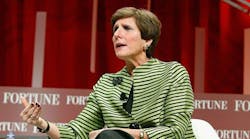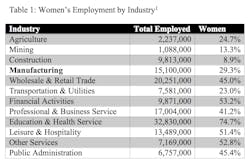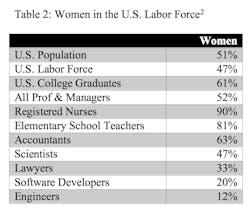The many challenges facing the manufacturing sector include recruiting, retaining and advancing top talent. Manufacturing needs leaders who will create the future and inspire innovation.
Research shows that women are ideally suited for this type of leadership, yet women continue to be under-represented in manufacturing at all levels. The data and research related to women in manufacturing create a compelling business case for having more women in manufacturing leadership. Fortunately, there are many effective strategies that leaders can adopt to increase the number and percentage of women in manufacturing.
Data compiled from the U.S. Bureau of Labor Statistics shows that manufacturing includes a little less than 30% women (Table 1), where the overall U.S. workforce is 47% women and women comprise 52% of all professionals and managers (Table 2).
Catalyst, an organization dedicated to accelerating the progress of women in the workplace, reports that in 2016, women comprised less than 30% of the S&P 500 durable goods manufacturing workforce, 20% of the executives and only 5% of the CEOs. The numbers are slightly better in non-durable goods manufacturing, where women comprise 36% of the workforce, 24% of the executives and 6% of the CEOs (Table 3).
More Women, More Money
Numerous research studies have identified a strong business case to increase the representation of women in manufacturing leadership. A recent meta-analysis of studies dating back to the 1990s shows that a firm’s financial performance increases when women are in more than token leadership roles. This is specifically true when a woman is the CEO. Having more women on corporate boards increases earnings and sales.
Putting more women on teams increases the collective intelligence of those teams and improves team performance. Innovation related to new product design also increases when teams are gender-equal. The bottom line from five decades of research on women in leadership is that there is an irrefutable and verifiable link between women in leadership and improved business performance.
While the business case supports the inclusion of women in manufacturing, the research is limited on how to effectively recruit, retain and advance women in these traditionally male-dominated organizations. Instead, the research has focused on why women leave male-dominated professions and organizations.
An overview of these studies shows that women leave due to a lack of promotional opportunities, a lack of challenging, novel and interesting work assignments, poor relationships with leaders and co-workers and bias in the workplace.
Pay is also cited as a reason women leave manufacturing, and data from the U.S. Bureau of Labor Statistics confirms a salary discrepancy, as women in manufacturing earned only 75.8% as much as men in 2015. Some women do leave the industry for family reasons, but the majority of women who leave manufacturing do not stay at home, but opt for a career in a different sector.
The research we have done at Case Western Reserve University shows that those women who persist in manufacturing organizations do so because they believe they will achieve, they have challenging and interesting work that leads to promotional opportunities, they have the support of their leaders, and they find meaning in their profession.
These women develop supportive relationships, not only at work but in their personal lives. These relationships help them navigate the sometimes difficult and mysterious career obstacles encountered in manufacturing. The women who persist have opportunities to develop their professional and leadership skills.
For manufacturing organizations that want to recruit, retain and advance women in their organizations, we recommend the following strategies:
- First, commit to an inclusive organization. Put goals in place for every level including at the highest levels of leadership. Identify the processes where women are excluded, such as in recruiting talent. Work with non-profits like Women in Manufacturing, AAUW, Catalyst and other organizations whose mission it is to increase the number of women in non-traditional careers.
- To retain women in manufacturing, make sure that women have work that is challenging and interesting. Help them develop a comprehensive plan for their career so that they know they can achieve. Include opportunities for women to develop their professional and leadership skills and competencies. We have found in the Leadership Lab for Women in Manufacturing offered by Women in Manufacturing and Case Western Reserve University, that about 40% of our graduates report promotions within a year of finishing the program. Participants also report a significant increase in self-confidence, a clearer vision of their future, and greater understanding of their strengths and how to leverage them within their organizations.
- Assign mentors and sponsors. Mentors are people in the organization who guide women on career choices and aid in the development of a long-term career plan. Sponsors are high-level leaders in the organization who can help women obtain high-visibility assignments and promotions.
Advancing women in organizations is often unfairly influenced by a societal bias that equates leadership with men. This is especially true in manufacturing, where the workforce continues to be dominated by men and women are still seen as “different.” Companies that recognize and mitigate these biases by developing processes and procedures to promote women to leadership will have a competitive advantage.
Organizational change is difficult, and creating an inclusive culture continues to be one of the toughest challenges facing manufacturing. Research shows, however, that taking the important step of developing and implementing an aggressive plan to increase the number of women in manufacturing, especially in leadership, will have a positive impact on the organization.
Kathleen Buse is an adjunct professor at Case Western Reserve University’s Weatherhead School of Management in Cleveland, Ohio.







